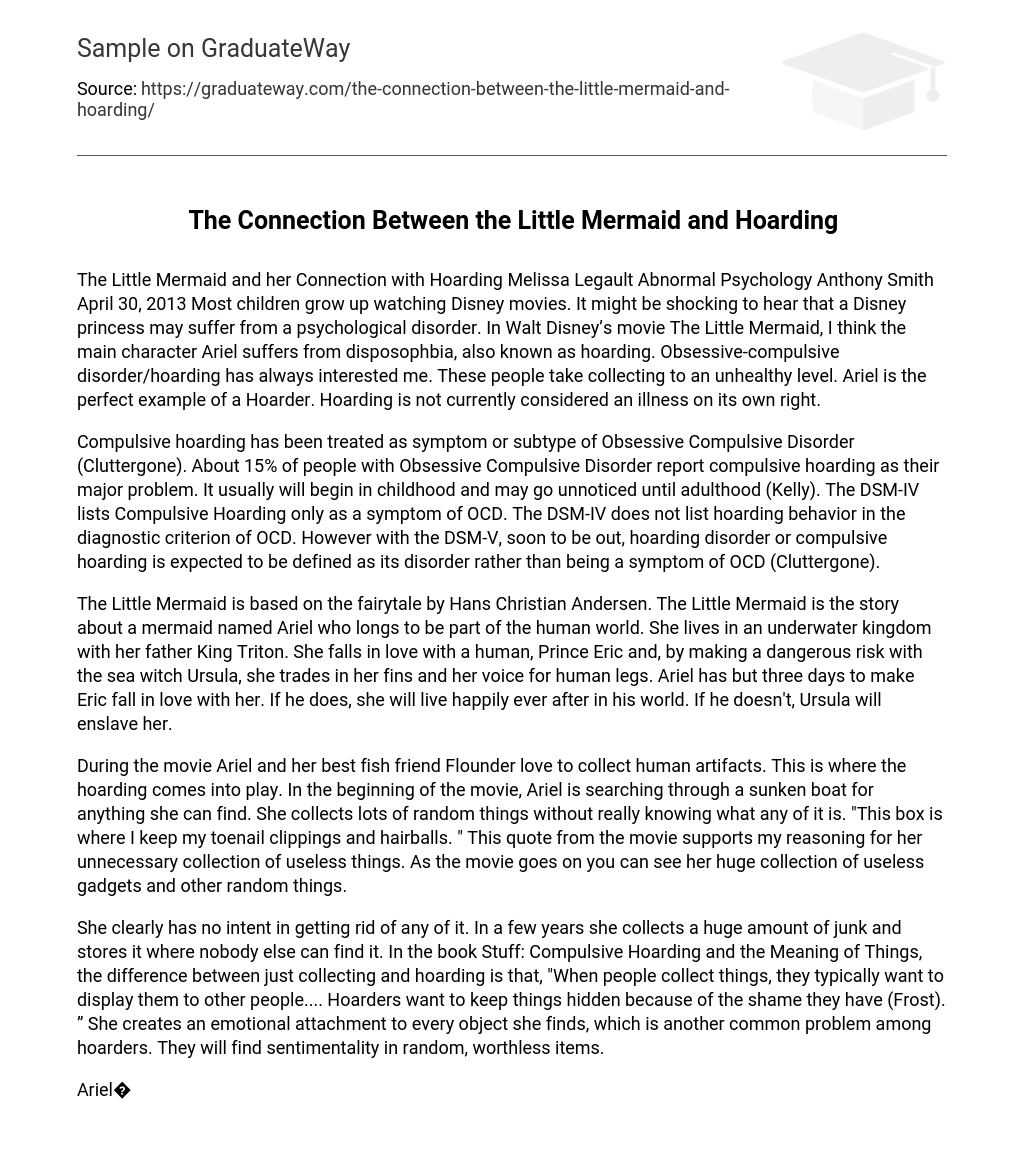The Little Mermaid and her Connection with Hoarding Melissa Legault Abnormal Psychology Anthony Smith April 30, 2013 Most children grow up watching Disney movies. It might be shocking to hear that a Disney princess may suffer from a psychological disorder. In Walt Disney’s movie The Little Mermaid, I think the main character Ariel suffers from disposophbia, also known as hoarding. Obsessive-compulsive disorder/hoarding has always interested me. These people take collecting to an unhealthy level. Ariel is the perfect example of a Hoarder. Hoarding is not currently considered an illness on its own right.
Compulsive hoarding has been treated as symptom or subtype of Obsessive Compulsive Disorder (Cluttergone). About 15% of people with Obsessive Compulsive Disorder report compulsive hoarding as their major problem. It usually will begin in childhood and may go unnoticed until adulthood (Kelly). The DSM-IV lists Compulsive Hoarding only as a symptom of OCD. The DSM-IV does not list hoarding behavior in the diagnostic criterion of OCD. However with the DSM-V, soon to be out, hoarding disorder or compulsive hoarding is expected to be defined as its disorder rather than being a symptom of OCD (Cluttergone).
The Little Mermaid is based on the fairytale by Hans Christian Andersen. The Little Mermaid is the story about a mermaid named Ariel who longs to be part of the human world. She lives in an underwater kingdom with her father King Triton. She falls in love with a human, Prince Eric and, by making a dangerous risk with the sea witch Ursula, she trades in her fins and her voice for human legs. Ariel has but three days to make Eric fall in love with her. If he does, she will live happily ever after in his world. If he doesn’t, Ursula will enslave her.
During the movie Ariel and her best fish friend Flounder love to collect human artifacts. This is where the hoarding comes into play. In the beginning of the movie, Ariel is searching through a sunken boat for anything she can find. She collects lots of random things without really knowing what any of it is. “This box is where I keep my toenail clippings and hairballs. ” This quote from the movie supports my reasoning for her unnecessary collection of useless things. As the movie goes on you can see her huge collection of useless gadgets and other random things.
She clearly has no intent in getting rid of any of it. In a few years she collects a huge amount of junk and stores it where nobody else can find it. In the book Stuff: Compulsive Hoarding and the Meaning of Things, the difference between just collecting and hoarding is that, “When people collect things, they typically want to display them to other people…. Hoarders want to keep things hidden because of the shame they have (Frost). ” She creates an emotional attachment to every object she finds, which is another common problem among hoarders. They will find sentimentality in random, worthless items.
Ariel’s hoarding also interferes with her normal life. She ditches her father by hunting for trash instead of going to a concert she promised to attend. One of the main side effects of disposophobia is obsessing over the collection at the expense of daily obligations. The word hoarding was originally used to describe the behavior of animals storing food for future use, and then moved into use as a descriptor of human behavior. There are also different types of hoarders. These include Clinical compulsive hoarding, OCD or perfectionist hoarding, animal hoarding, and Diogenes syndrome.
Clinical compulsive hoarding is the most common type, while Diogenes syndrome is very rare. Diogenes syndrome is a disorder of self-neglect that is associated with severe personality disorders, most common in the elderly. Most of the research carried out on compulsive hoarding is around the relationship between Obsessive Compulsive Disorder and hoarding. New research has raised doubts about the OCD connection. Researchers have learned that while some hoarding behaviors would respond to OCD treatments, some will not (Cluttergone) This is what I believe Ariel’s case to be.
I do not think she suffers from both Obsessive Compulsive disorder and hoarding. Not much is understood about the causes of hoarding, which is thought to affect over a million Americans. Compulsive hoarders may have a difficult time getting rid of objects because they are anxious they will need them in the future, feel the items have sentimental value or do not want to be wasteful. Most people that suffer from hoarding often can’t sit in their living rooms, sleep in their bedrooms or cook in their kitchens.
Many have a narrow path from room to room in their homes to navigate through the clutter. It may be very difficult to find a valuable item in all the mess. There many safety hazards, such as tripping over piles, or the danger of fire with stacks of papers all over the house. The people who live in houses with excessive clutter are at risk of more health problems from the excess amount of dust, mildew and fungus that can be caused by the disorder (Wilson). As you can see Ariel is a prime example of a hoarder.
Her unhealthy habits go unlooked to most people, but when you really look at the bigger picture, she is a collector of useless junk. References Cluttergone ((n. d. )). Retrieved from http://www. compulsive-hoarding. org/Definition. html Frost, Randy O. Steketee, Gail. (2010) Stuff :compulsive hoarding and the meaning of things Boston : Houghton Mifflin Harcourt, Kelly, P. D. (n. d. ). Retrieved from http://ocd. about. com/od/glossary/g/Hoarding. htm Wilson, E. (n. d. ). Retrieved from http://www. alternet. org/story/111030/how_compulsive_hoarding_can_threaten_your_health_and_take_over_your_life





